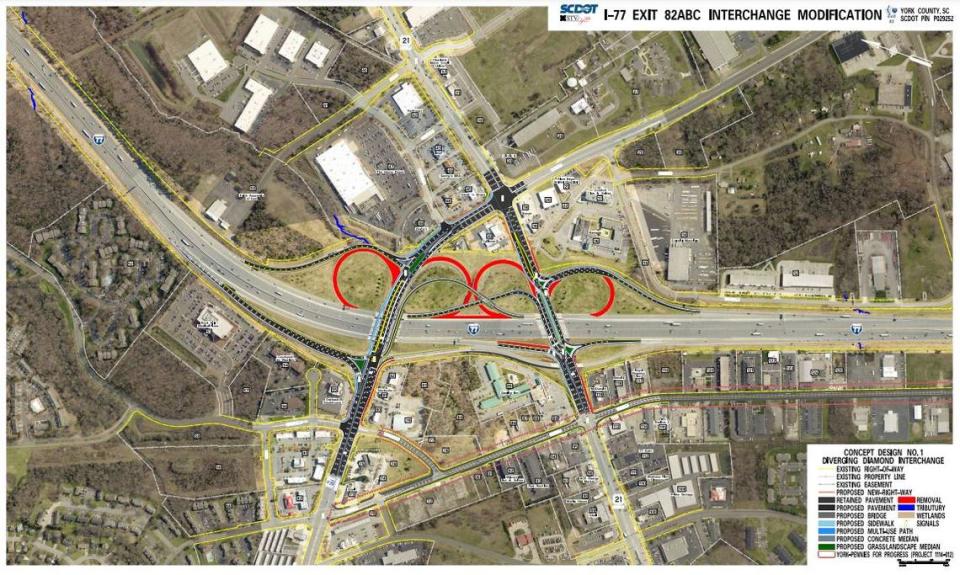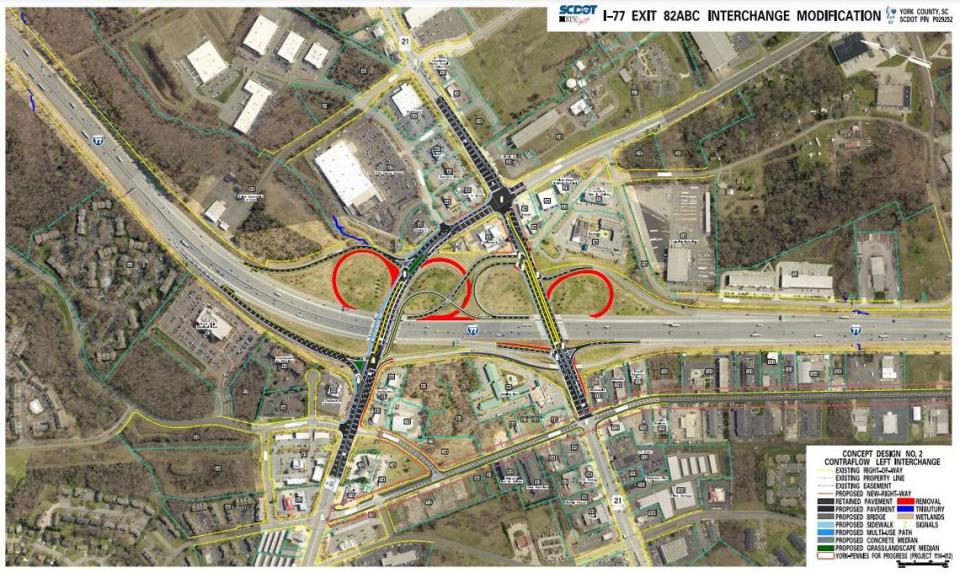Traffic at Rock Hill I-77 exit could ‘double in every direction,’ planners say
Mayors and road planners say they want to learn from past projects before settling on final designs for a critical Rock Hill interchange.
They also want to temper public expectations.
The reconfiguration of Exit 82 in York County is a top area priority. It’s long been a choke point and spurred debate a decade ago about another bridge over the Catawba River to alleviate congestion. The South Carolina Department of Transportation is now designing a way to upgrade Exit 82. A final configuration could come later this year.
Traffic will improve where Cherry and Celanese roads hit I-77, experts say. It won’t disappear.
“There’s no silver bullet that’s going to make everything better for everybody,” said Berry Mattox, project manager with SCDOT.
David Hooper, administrator with the Rock Hill-Fort Mill Area Transportation Study (RFATS), said the Rock Hill interchange is complex. It’s the only one in the area where two major roads share one interchange, Hooper said.
And modeling actually shows more traffic coming.
“Demand is virtually slated to double in every direction,” Hooper said.
New interchange options
Mattox and other road officials held a public meeting in February to outline some options.
They showed a diverging diamond setup — similar to I-77 and Gold Hill Road between Fort Mill and Tega Cay. Another option, called a contraflow left, would use new lanes to avoid left turns.
Mattox said final design could be either, some combination or something new.
Here’s how the new Cherry and Celanese road intersection at Interstate 77 could look
On Friday, Mattox updated the RFATS policy committee. One concern: the need to keep traffic moving while improvements are made.
“Obviously we want to maintain traffic throughout construction,” Mattox said. “We know that people aren’t going to stop going to work when we’re building.”
Other factors that will steer the design decision are loop ramps, how changes affect traffic lights, widening of U.S. 21 in Fort Mill (which becomes Cherry Road in Rock Hill) as part of an interchange upgrade at Exit 85 and the new Exit 81 under construction where the Carolina Panthers headquarters site would’ve been.
On Friday, Mattox said a combination of the two designs presented in February is gaining momentum. The designs could include a diverging diamond at Celanese Road and a modified contraflow look — minus one ramp from what the public saw in February — at Cherry Road. Mattox stressed no final decisions have been made.
“We like where this is heading,” Mattox said of those options.


Diverging diamond problems?
Fort Mill Mayor Guynn Savage, a policy committee member, cautioned her counterparts in Rock Hill to look closely and critically at the diverging diamond option before committing to it.
“What data do you have to support that it works?” Savage said, referencing the first-in-the-state diverging diamond at Gold Hill Road. “Because I can tell you it is still as congested as it ever was, and it’s even more dangerous.”
York County Councilman Tom Audette said he got lots of calls about Gold Hill Road early on — particularly the timing of the traffic signals. Tega Cay Mayor Chris Gray said he heard complaints about a lack of lighting on roads.
“They couldn’t see at night,” Gray said.
Road planners said there were issues at the beginning with the diamond on Gold Hill, but they were largely resolved with final pavement markings and signs.
“I’ve heard very little negative feedback (since),” said Patrick Hamilton, who manages Pennies for Progress in York County.
Vic Edwards with SCDOT said traffic improved as the public acclimated. Which isn’t to say Gold Hill is perfect now. There may never be design changes that fix everything, Edwards said.
“There’s probably not one at Gold Hill either,” Edwards said.
Rock Hill Mayor John Gettys pointed to other parts of the project that involve Riverview Road and Riverchase Boulevard. Fixes at those roads, including changes to a traffic signal, are just a few years old.
“Surely there’s some report we’ve done to see if we accomplished our objective,” Gettys said.
That’s what Savage wants at Gold Hill — to help planners decide if a diamond is the best fit in Rock Hill.
“I would like to think that when we spend that sort of money,” Savage said, “that it’s obvious.”
Ongoing traffic problem
SCDOT traffic count figures show the ramps at Gold Hill see 5,600 to 11,100 vehicle trips per day on average. The nearest count sites to it show 24,900 vehicle trips on Gold Hill Road and 11,100 from Springfield Parkway.
At Cherry and Celanese, the ramps see 8,900 to 25,700 vehicle trips per day on average. The area between those ramps sees 71,900 vehicles. Just west of the interchange, Celanese Road shows 47,400 vehicle trips and Cherry shows 41,200 trips.
The interstate has more traffic at Gold Hill, likely due to its closer proximity to Charlotte. Interstate counts immediately above and below the Gold Hill interchange average 124,000 vehicle trips per day. The Cherry and Celanese interchange sits between counts of 119,800 trips on the Fort Mill side of the Catawba River bridge and 90,200 trips near the new Exit 81.
Road planners know traffic is an issue now, and they know more demand is coming. They also know fixes to push traffic through key intersections will only invite more traffic.
“By the time we catch up, the demand is greater than when we started,” Mattox said.
Chief Bill Harris with the Catawba Indian Nation said despite efforts of groups like SCDOT, Pennies or RFATS, people in this area have to acclimate themselves with the idea that traffic is never going to be ideal. It’s been an issue for years and will remain one, even with planned fixes.
“Unless you close the borders you’re never going to solve this,” Harris said, “and nobody wants to close the borders.”

